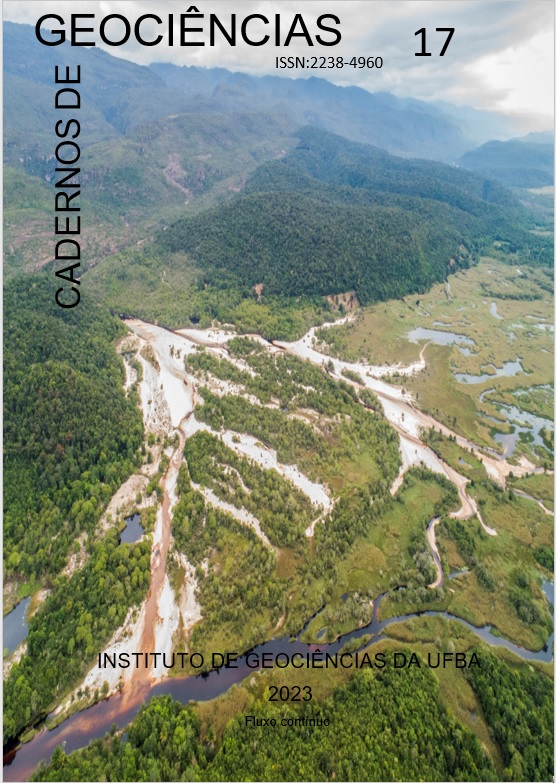The ISOTOPIC ANALYSIS ON THE ORIGIN OF WATER IN THE MARIMBUS WETLAND, CHAPADA DIAMANTINA, BRAZIL
ISOTOPIC ANALYSIS
DOI:
https://doi.org/10.9771/geocad.v17i0.53958Keywords:
Marimbus wetland; isotopic analysis; Chapada DiamtinaAbstract
The Marimbus wetland is located in a lowered valley and made up of alluvial sediment, resembling flooded sinkholes where we find a backswamp in drylands that remains permanently-to-seasonally flooded in the Chapada Diamantina. To determine the origin of the Marimbus wetland waters, isotopic analyses were performed at several points. The samples presented values of δ18O and δ2H ranging from -21.1 ‰ to 9.0 ‰ and from -3.13 ‰ to 3.31 ‰, respectively. Most of the samples presented data coinciding with the global meteorological curve. The sinkhole’s morphological features do not prove that the waters of the Marimbus wetland area are of karstic origin since the isotopic signature is within the global meteoric curve, indicating that its source was rainfall and that it is undergoing intense evaporation. They are rounded-shaped ponds typically found in alluvial fans and floodplains.
Downloads
References
BARBIÉRO, L., QUEIRÓZ-NETO, J. P., CIORNEI, G., SAKAMOTO, A. Y., CAPPELARI, B., FERNANDES, E., VALLES, V. Geochemistry of water and groundwater in the Nhecolândia, Pantanal of Mato Grosso, Brazil: variability and associated process. Wetlands, 22:528-540, 2002. https://rdcu.be/cv1Xs.
BRAND, W. A., AVAK, H., SEEDORF, R., HOFMANN, D., CONRADI, T. New methods for fully automated isotope ratio determination from hydrogen at the natural abundance level. Geoph. Prosp, 28:967-976, 2000.
CRAIG, H. Isotope variations in meteoric waters, Science, 133:1702-1703, 1961.
KOPPEN, W. Das geographisca System der Klimate, in: Handbuch ¨ der Klimatologie, edited by: Koppen, W. and Geiger, G., 1. C. ¨Gebr, Borntraeger, pp1–44, 1936.
LISENBY, P. E., TOOTH, S., RALPH, T. J. Product vs. process? The role of geomorphology in wetland characterization. Science of the Total Environment, 663:980-991, 2019. https://doi.org/10.1016/j.scitotenv.2019.01.399
MAGALHÃES, A. J. C., RAJA GABAGLIA, G. P., SCHERER, C. M. S., BÁLLICO, M. B., GUADAGNIN, F., BENTO FREIRE, E., SILVA BORN, L. R., CATUNEANU, O. Sequence hierarchy ina Mesoproterozoic interior sag basin: from basin fill to reservoir scale, the Tombador Formation, Chapada Diamantina Basin, Brazil. Basin Research, 28:393-432, 2015. http://dx.doi.org/10.1111/bre.12117
MARTINS, A. A. M., FILHO, E. L. A., LOUREIRO, H. S. C., ARCANJO, J. B. A., GUIMARÃES, J. T., GUIMARÃES, R. V. B. Geologia da Chapada Diamantina ocidental (Projeto Ibitiara Rio de Contas). Companhia Baiana de Pesquisa Mineral (CBPM), 2008. Publishing Physics web. Available at: http://www.cbpm.ba.gov.br/book/geologia-da-chapada-diamantina-ocidental-projeto-ibitiara-rio-de-contas/.
PEREIRA, R. G. F. A. Geoconservação e desenvolvimento sustentável na Chapada Diamantina (Bahia Brasil). Dissertation, Universidade do Minho, 2010.
ROZANSKI, K., ARAGUÁS-ARAGUÁS, L., GONFIANTINI, R. Isotopic patterns in modern global precipitation. In: Swart PK, Lohman KC, McKenzie J, Savin S (eds) Climate Change in Continental Isotopic Records – Geophysical Monograph 78. American Geophysical Union, Washington, DC, pp 1–36, 1993. https://doi.org/10.1029/GM078p0001
SALLES, L. S. Q. Ferramentas hidrogeoquímicas e isotópicas (δ18O e δ2H) aplicadas no entendimento do processo de salinização da água subterrânea em aquíferos carbonáticos proterozoicos: evidência do semiárido do nordeste brasileiro. Dissertation, Universidade Federal da Bahia, 2017.

